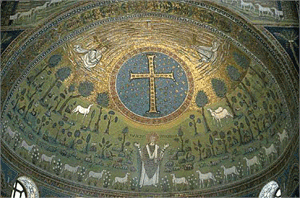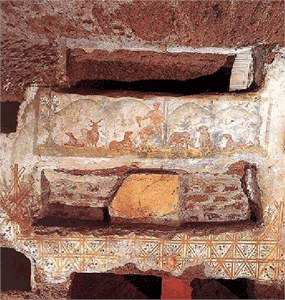
Christmas
Easter
Pentcoest
All Saints
Christ The King
Confirmation
Palm/Passion
Reformation
Stewardship
Books of the Bible
Lenten Series
Christmas Dramas
Videos
Series A - Matthew
Series B - Mark
Series C - Luke
Series D - Other
To contact
Edward F. Markquart
info@sfs.com
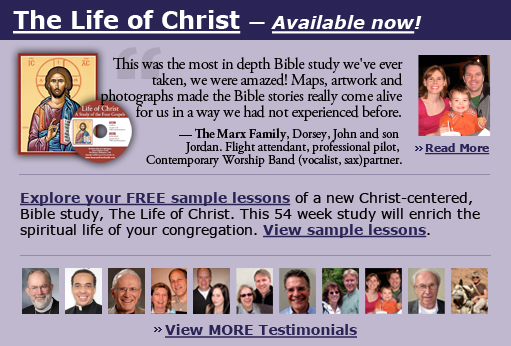
Series A, B, C Series A John 10:1-10 I AM THE DOOR Series B John 10:11-18 I AM THE GOOD SHEPHERD Series C John 10:22-30 NO ONE CAN SNATCH THEM OUT OF MY HAND The following Bible study is from a larger course entitled, THE LIFE OF CHRIST: A Study in the Four Gospels. This 54 week course for the laity will be available for congregations in 2008. Basic text for the course: SYNOPSIS OF THE FOUR GOSPELS, Kurt Aland, English Edition, P. 220. LARGER CONTEXT: THE GOOD SHEPHERD CHAPTER OF JOHN 10 #249. I Am The Good Shepherd John 10:1-18 PAINTING AND IMAGINATION: JESUS THE GOOD SHEPHERD
|
| Discussion Question: What does it mean for you that God has given you life? What does it mean that Christ has given you eternal life? |
This ends the gospel text for Easter 4A.
The following is the gospel text for Easter 4B.
-I am the good shepherd. This phrase could be translated the “model shepherd,” the “noble shepherd,” “the ideal shepherd,” “the beautiful shepherd,” or “the perfect shepherd.” We heard this same word, “good,” in John 2:10 during the marriage feast, “You have saved the good wine until now.”
http://www.utilitarianism.com/jesus-christ.jpg
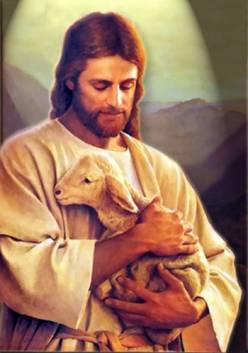
http://www.geocities.com/francischinchoy/jcshepherd.jpg
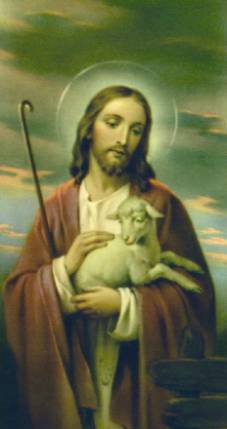
http://207.200.19.180/images/10000/3000/486IN/user/Jesus%20the%20Good%20Shepherd.jpg
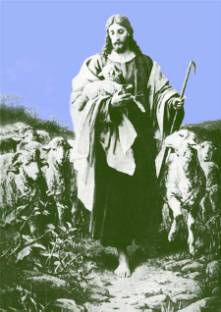
-The good shepherd lays down his life for the sheep. A primary characteristic of a good shepherd is that he is willing to die for the sheep. Jesus, of course, is describing his own life in that Jesus was willing to die on the cross that others might live. The Gospel of John likes this phrase (“lays his life down”) and we see it in John 8:37, 15:13 and I John 3:16. In this passage here in John 10, we hear the phrase, “lays his life down” five times within one chapter. Highlight each of those phrases as we study this chapter.
In the Old Testament, a shepherd did not lay down his life for the sheep. This is a new concept/understanding/knowledge in the New Testament that a shepherd would die for the sheep. Nowhere, not once, in the Old Testament does a shepherd lay down his life for the sheep.
“The idea of a voluntary and vicarious death for the sheep is not found in the Old Testament nor elsewhere (Jeremias 1968:496-97; Barrett 1978:374).” JOHN, Bible Gateway, Commentary.
This idea of “laying down his life for the sheep” cannot be underestimated and is at the core of Christianity.
-I am the good shepherd. I know my own and my own know me. Another characteristic of a good shepherd is that he knows his own sheep. The sheep belong to Jesus and he knows them/us. We know the voice, the actions, the attitudes of the good shepherd as well. Circle the word, “own.” The word, “own,” is used five times in this short text and indicates that we personally belong to God/Jesus, our Good Shepherd.
-I know the Father and the Father knows me. Jesus has repeatedly told us that he intimately knows the Father and the Father intimately knows the Son. The Pharisees cannot accept this concept, that Jesus knows the Father intimately, that God is his Father, and that he, Jesus, has been sent from the Father to earth. If God is Jesus' Father, than makes Jesus God's Son. For saying that and implying that he was the Son of God, the Pharisees wanted to kill Jesus.
-I lay down my life for the sheep. This is the primary mark of a good shepherd. He is willing to die that the sheep might live. That is what the story of the cross is all about. This idea is found nowhere in the Old Testament. This idea is the essence of Jesus, the noble shepherd. The idea of "laying down one's life for another" is at the heart of Christianity. But the Christian faith is not so much an idea about "laying down one's life for another" but doing it.
-I have other sheep that are not of this fold. I must bring them also, and they will heed my voice. Jesus is laying the groundwork for his ministry to the Gentiles, to all the world who are not Jewish or of Jewish descent. Jesus, the good shepherd, will reach out to save all the sheep of the world.
-So there shall be one sheep herd (flock) and one shepherd. Later in this gospel, Jesus called for oneness in his church. John 17:20-23: "My prayer is not for them alone. I pray also for those who will believe in me through their message, that all of them may be one, Father, just as you are in me and I am in you. May they also be in us so that the world may believe that you have sent me. I have given them the glory that you gave me, that they may be one as we are one: I in them and you in me. May they be brought to complete unity to let the world know that you sent me and have loved them even as you have loved me.” Jesus wants to bring all people into complete unity. (See also John 11:52, P. 224, “Jesus should die for the nation and not only for the nation only, but to gather into one the children of God who are scattered abroad.”)
Raymond Brown, JOHN, V. 2, P. 387. “One sheep herd, one shepherd. We are attempting to preserve here the closeness in the Greek between ‘poimne’ (sheep herd) and ‘poimen’ (shepherd).”
This does not mean that Jesus envisioned one world wide and universal denomination. Raymond Brown wrote, “Such an interpretation of the intention of the evangelist seems anachronistic. It belongs more to the modern concern with a divided Christianity and the ‘branch’ theory of the Church.” JOHN, V. 2, P. 387.
-For this reason the Father loves me because I lay down my life that I may take it again. There is that phrase again, "I lay down my life." That is the invitation for all people who want to follow Christ: to lay down our lives for others that they and we may find life. This is the way to live: in selfless love for God and others. When we live that way, we find life. That is, we take it back again.
-No one takes it from me, but I lay it down of my own accord. I have power to lay it down, and I have power to take it up again. Jesus is telling us that he has the power within himself to freely lay down his life for others or not to do so. We too can live this way.
-I have received this command from my Father." Jesus has received his command from his Father and we receive the same command. That is, we too are invited to lay down our lives for others.
The gospel for Easter 4B ends here.
#250. Division Among the Jews Again
John 10:19-21
-There was again a division among the Jews because of these words. Many of them said, “He has a demon. He is mad. Why listen to him?” Others said, “These are not the sayings of one who has a demon. Can a demon open the eyes of the blind?” We know that many Jewish leaders who opposed Jesus, thought that he was crazy, a madman, a spiritual lunatic who thought he was God. “Madness was thought to be a result of demonic possession.” (Brown. V. 2, P. 387) On certain levels, we can sympathize with these Jewish leaders. If one of our friends claimed that they were God and had God’s power within, we would think of that person as crazy or a madman.
#257. Jesus at the Feast of Dedication in Jerusalem
John 10:22-39
This begins the gospel text for Easter 4C.
-It was the feast of the Dedication in Jerusalem. It was winter and Jesus was walking in the temple, in the portico of Solomon. Previously, in John 7:2, we knew that Jesus was in Jerusalem at the Feast of the Tabernacles. That meant it was autumn because the Feast of Tabernacles was also a Feast of Ingathering similar to our autumn feast of Thanksgiving. In the scenes in John, chapters 7-9, Jesus continued to teach in the temple in late autumn.
But in this passage from John 10:22, two-three months have passed and it was winter or wintry weather as in the month of December. It was the Feast of Dedication, the Feast of Hanukkah. Hanukkah commemorates Judas Maccabeus and the Maccabeans driving out the Syrians, building a new altar, and rededicating the temple with a new altar. This Maccabean war was from 167-164 BCE. Near the phrase, “feast of the Dedication,” write the word, “Hanukkah,” Near the word, “winter,” write the word, “December. Two months later.”
This Bible verse gives a definite picture of the setting in the Temple, in the portico of Solomon. Raymond Brown has an insightful paragraph: “The outermost court of the Temple was surrounded by magnificent covered colonnades or cloisters on all four sides. Those porticoes were open on the inside facing the temple, but closed on the outside. The oldest portico, the one on the east side, was popularly associated with Solomon, the builder of the first temple.” “There is one detail of local color that is very accurate. At this winter season, when the cold winds sweep in from the east across the great desert, we find Jesus in the east portico of the Temple, the only one of the porticoes whose closed side would protect it from the east wind.” (Brown, JOHN, V. 1. P. 402, 405)
In the diagram below, locate the porticoes which were hallways with columns. Click the link and the image will be clearer.
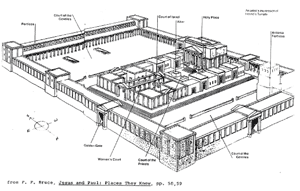
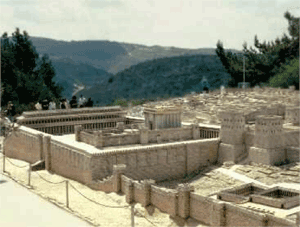
See the model of the porticoes. This model is from the Jerusalem Hotel.
-The Jews said to him, “How long will you keep us in suspense? If you are the Christ, tell us plainly.” The Jewish leaders wanted to know if Jesus Christ was really the Messiah. To these Jewish leaders, Jesus’ previous answers about his identity had been philosophically oblique and confusing. The Jewish leaders wanted a direct answer from him, so that they could build a legal case against him.
-You do not believe me because you do not belong to my sheep. Once again, Jesus “hit the nail on the head.” The Jewish leaders didn’t believe in Jesus because they were not his followers, his disciples, or his sheep.
-My sheep hear my voice and I know them and they follow me. People who believe in Christ hear his voice, his teachings, his truths about God and the way to live and love. Such people follow Christ and are disciples of Christ. The Jewish leaders did none of these things. They hated Christ and wanted him killed. Why? Because Jesus was destroying their cushy, power hungry, wealthy way of life. But his disciples were like sheep who followed their shepherd. Focus on the word, “follow.” The mood of the word, “follow,” in like sheep following a shepherd, more so than a slave following an owner or a soldier following a captain. The word, “follow,” in the gospels is connected with a shepherd, not soldiers nor slaves.
-And I give them eternal life and they shall never perish and no one shall snatch them out of my hand. What promises Jesus was making to his followers, to his sheep who follow him! Eternal life. Eternal assurance. “No one shall be able to snatch them out of my hand. No one shall be able to snatch them out of the Father’s hand.” That is precisely what the bad shepherd wants to do: snatch them out of the Father’s hand. That is what the power of evil wants to do with our lives: snatch us out of the hand of Christ. The purpose of the power of evil is to snatch us from the hands of our loving Father. Jesus promises to us that such “snatching” will not occur in our lives.
-No one is able to snatch them out of the Father’s hand. When we are in the grip of God’s loving hands, nothing evil can snatch us away from a Father who holds us firmly in his love.
-I and the Father are one. The Father and the Son are one, are unified, are of one mind, one purpose, one way of living. The Son repeats the attitudes and actions of the Father. The two think and act alike. Underline this phrase. Circle it. Highlight it.
Here ends the gospel text for Easter 4C.
-The Jews took up stones again to stone him. The Jewish leaders knew that Jesus had crossed the line and was identifying himself as none other than God. For this, Jesus could be stoned for blasphemy.
-The Jews answered him, ‘It is not for a good work that we stone you but for blasphemy, because you, being a man, make yourself God.” This is the key. The Gospel of John makes the charges against Jesus crystal clear: “Blasphemy.” This gospel defines what blasphemy is, “making yourself God.” At the end of the Jesus Story during Holy Week in Matthew and Mark, Jesus will be accused of blasphemy but this is the only Bible verse that clearly defines what blasphemy is. What is blasphemy? “Making yourself God.”
-Jesus answered them, “Is it not written in your own law, ‘I said, You are gods? If he called them gods to whom the word of the Lord came (and Scripture cannot be broken), do you say of him whom the Father consecrated and sent into the word, ‘You are blaspheming’ because I said, ‘I am the Son of God.” “In response to the charges of the Jews that he is making himself God, Jesus answers with reasoning drawn from the Old Testament. He cites from Psalm 82:6. Psalm 82:6 itself and the rest of the verse and the context of the verse are important in the argument. The whole verse reads, ‘I say, ‘You are gods, sons of the Most High, all of you.’ Jesus is interested not only in the term “gods,” but also in the synonymous expression “sons of the Most High” for he refers to himself as the Son of God in verse 36.” Brown, JOHN, V. 1, P. 409.
Above this quotation from the Old Testament, write: “Jesus quotes Psalm 82:6, ‘You are gods, sons of the Most High, all of you.’” Jesus again uses reasoning drawn from the Old Testament. In this situation, Jesus reasons that when he calls himself “the Son of God,” the Old Testament also calls people, “sons of God.”
Brown continues, “First, if there was a common practice in the Old Testament to refer men like the judges as ‘gods,’ and this was no blasphemy, why do the Jews object when this term is applied to Jesus. To a Western mind, this argument seems to be a deceptive fallacy. The Jews are not objecting that Jesus is raising himself to the level of a god in the sense in which the judges were gods. They are objecting that he is making himself God with a capital, ‘G.’” Brown, JOHN, V. 1, P. 409.
-Even if you don’t believe me, believe the works (that I do) that you may know and understand the Father is in me and I am in the Father. Jesus wants us to know that he is in the Father and the Father is in Jesus. To see Jesus is to see the Father; to know Jesus is to know the Father; to love Jesus is to love the Father.
-Again they tried to arrest him, but he escaped from their hands. Jesus’ speech in the temple that day gave the Jewish leaders specific legal grounds to stone him. But the time for Jesus’ death had still not arrived, and so Jesus again escaped from their hands and withdrew across the Jordan River.
![]()
![]() Back to Top
Back to Top
